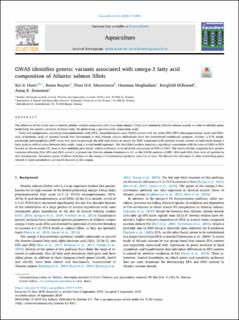| dc.description.abstract | The objective of this study was to identify genetic variants associated with long-chain omega-3 fatty acid content in Atlantic salmon muscle, in order to identify genes underlying the genetic variation in these traits, by performing a genome-wide association study. Fatty acid composition, including eicosapentaenoic acid (EPA), docosahexaenoic acid (DHA) content and the ratios DHA/DPA (docosapentaenoic acid) and DHA/ALA (α-linolenic acid) of skeletal muscle was determined in 642 Atlantic salmon individuals from the Salmobreed broodstock program. Further, a 57 K single-nucleotide polymorphism (SNP) array was used to genotype the 642 individuals to search for SNPs associated with skeletal muscle content of individual omega-3 fatty acids as well as ratios between fatty acids, using a mixed model approach. We identified markers showing a significant association with the ratio of DHA to DPA located on chromosome 19, close to the candidate gene elovl2, which is directly involved in the conversion of DPA to DHA. The results further suggested that genetic variation affecting fillet EPA and DHA content is present on Atlantic salmon chromosome 21, as the GWAS analysis of EPA, DHA and DHA/ALA ratio all pointed to this chromosome. No known genes of direct relevance to the omega-3 bioconversion pathway were found here. We discuss the relevance of other interesting genes related to lipid metabolism and health located in this region. | |
